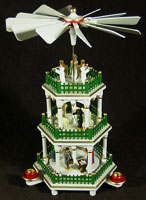German Christmas Traditions - The Christmas Tree
German Christmas Traditions - The Christmas Tree
O Christmas tree. O Christmas tree,
Thou tree most fair and lovely.
The sight of thee at Christmas-tide
Spreads hope and gladness far and wide.
Throughout the holiday of Christmas, we have numerous traditions and emblems, which help make this holiday special and unique to each family. One of the most prevalent Christmas traditions is that of setting up and decorating the family Christmas tree. The Christmas tree is seen today as an icon symbolizing the winter holiday and the festivities that surround it. Like other holiday icons associated with Christmas, like stars, candy canes, nutcrackers, Santa, mistletoe, etc., the Christmas tree also has historical roots in Europe and Germany. Typically, Christmas trees are decked out with lights and are covered with an assortment of tinsel and ornaments. You can find versions of these trees in many German Christmas gift import shops.
The origination of the Christmas tree, used in winter holidays, predates the actual celebration of Christmas. The first use of these trees relates to the winter solstice or the longest day in winter. As evergreen trees remain green all-year long, they were seen as good luck, reminding people during the long winter that the green of spring was months away. Although each culture through history has different names for this festive period, they all share one thing in common, the use of branches and wreaths in their celebrations. Many solstice celebrations also included giving gifts.
Later, during the period of Constantine, when Christianity gained in popularity, the celebrations of the solstice diminished, but the traditions of decorating one's home with greenery in the winter continued. Before calendars were available for the common man, people counted years by the position of stars and by the length of the day. The year was said to begin after solstice. The early Christian church would try to go through the stories of the Bible each year. As most people were unable to read, these stories were dramatized. One of the first stories re-enacted after the solstice was the Paradise story, where sin was introduced to the world through Adam and Even and the Tree of Good and Evil. Germanic peoples began to recognize this story by decorating an evergreen tree, symbolizing the "tree," with apples, which stood for "sin", and other little ornaments and placing them in their homes. Before long, this became a popular trend and with the birth of Christmas or Christ-Kindl mass (literally: Christ child mass) during the reformation the tree was philosophically re-assigned to this new holiday. Later, stars were included into the tree in the form of candles. Christmas trees became a commodity regularly found in German Christkindl markets. Today a variety of them can be purchased here in the states through German import shops.

As wood was a limited and precious commodity and people could not justify cutting down a tree merely for decoration, the early German Christmas trees utilized A-frames with boughs attached to them or used candle pyramids. These were the first re-usable Christmas trees. They were able to maintain the holiday spirit and yet conserve forestry resources. Unfortunately, these did not gain mainstream popularity. Although many homes include the German candle pyramid, or carousel, into their holiday decorations these have not been able to replace the actual Christmas tree.
Another type of re-usable Christmas tree that was used early on in Germany are shaved trees. These are usually small table toppers ranging from mere inches in height to just under a foot. The shaved tree is made from a single branch or log from a Linden or Beech tree. The craftsman shaves and whittles the wood until it resembles an evergreen tree with curving branches.
How did the Christmas tree come to represent Christmas worldwide, not only in Germany where the tradition originated? The tree became popular in England after Queen Victoria, who set the fashionable trends in Europe, set up a Christmas tree on behalf of her Germanic husband, Prince Albert. The tree migrated the Atlantic Ocean to come to the states through marketing ploys aided by the influx of German immigrants to the United States.

In Germany, Christmas trees traditionally are unveiled fully decorated on Christmas Eve and then remains up in the home until the 12th day after Christmas (the twelve days of Christmas) this entire period is filled with celebration as they also celebrate the New Year. In the States, Christmas trees are typically decorated as a family activity the weekend of Thanksgiving. Commercialism and the growing desire to sell more gifts has led stores to begin putting up Christmas decorations back in October. This is a shame as it takes the uniqueness of the holiday's away and uses the Christmas tree, not as a reminder of the growth to come, but rather as a marketing ploy. Instead of encouraging the dilution of Christmas to mercantilism and mass marketing, take a moment to step back, sip some glüwein, take a moment to decorate your tree, thinking of those you love, reminding you of Christmas' past, and add some German handcrafted unique pieces to your Christmas experience.
